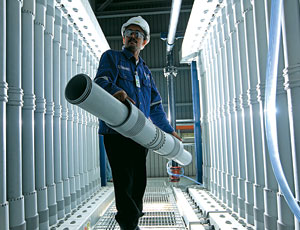As more of the world’s economies show signs of transitioning from recession to recovery, the relatively unscathed global environmental sector appears poised to resume its growth.
Most of the markets that were strong before the recession—East Asia, Australia, and Western Europe—have remained active, thanks in part to their projects’ inherent size and scope. “It’s been said that Asia is leading the world out of recession, and that’s probably also true for the water market,” says Dan McCarthy, president and CEO of Overland Park, Kan.-based Black & Veatch’s global water business.

For example, Black & Veatch is working on increasing the capacity of Singapore’s $60-million Sembcorp Changi NE- Water drinking-water plant from 69 million liters of water per day to 228 mld, using a combination of microfiltration and ultrafiltration membranes, reverse-osmosis membranes and ultraviolet light to treat the water. The firm also is expanding the Tai Po Water Treatment Works in Hong Kong from 66 million gallons per day to 211 mgd, integrating space-saving aerated biological filtration and dissolved air flotation technology to accommodate a constrained site.
At the other end of the recovery spectrum, new opportunities in Western Europe may be limited. The latest five-year price structure issued by the Water Services Regulation Authority, which regulates the water and wastewater industry in England and Wales, calls for only limited rate increases, potentially curbing utilities’ facility improvement plans.
Cost concerns also may lead more cash-strapped utilities to adopt alternative project-delivery strategies. In Hong Kong, Los Angeles-based AECOM is owner’s representative for the 60-million-gallon-per-day Pillar Point and San Wai wastewater treatment plants. Both design-build projects are part of the city’s multibillion-dollar Harbor Area Treatment Scheme, which aims to provide sewage collection and treatment infrastructure to address longstanding water-quality issues.
Australia is increasingly using the two-stage Alliance Model, a hybrid of design-build and design-bid-build, for projects such as the 38-kilometer-long Toowoomba Pipeline and associated infrastructure near Brisbane. The $187-million project will transfer up to 18,000 megaliters of water each year from Wivenhoe Dam to Cressbrook Dam, helping secure the parched area’s future water supply.
“Clients [want] a higher level of price certainty and less risk,” says Rob Andrews, AECOM global water managing director.
Some firms are seeing a surge of projects that combine desalination with reclamation. For example, Trinidad and Tobago’s Water and Sewerage Authority recently selected AECOM to serve as program manager for an $880-million, four-plant, 78 mgd desalination program and a 26.4-mgd water reclamation project at an existing wastewater treatment plant. “Keeping water in the watershed is becoming a new mantra, by using decentralized facilities to manage water in a more local manner without exporting ‘once-used’ water resources to rivers or the ocean,” says Bill Dee, president and CEO of Malcolm Pirnie, White Plains, N.Y.
Corporate Cleanups
For Fortune 500 companies with contaminated site liabilities, cleanup operations were slowed but not fully stopped by the recession. “Many of the environmental cleanup projects that were on discretionary schedules have been delayed, but we are seeing recovery in this market,” says Bob Goldman, global director of environment for ARCADIS, Denver. He adds there is considerable interest in portfolio-level management of multiple cleanup projects, “in some cases bundling projects into programs at fee levels exceeding $100 million,” he says.
Robert Weber, group chief executive for AECOM Environment, Westford, Mass., adds that many developing economies in Central Europe, as well as across Asia—in Turkey, the Philippines and Malaysia—are developing a regulatory framework for site remediation with the long-range goal of attracting future growth.




Post a comment to this article
Report Abusive Comment